Ammonite
Ammolite ~~ Ammonite ~~ Unearthed ~~ Misc Info ~~ Gem Stones ~~ Lore ~~ Rockhounds
Ammonite fossils show the shape of the creature. Ammolite is the shell of the creature.
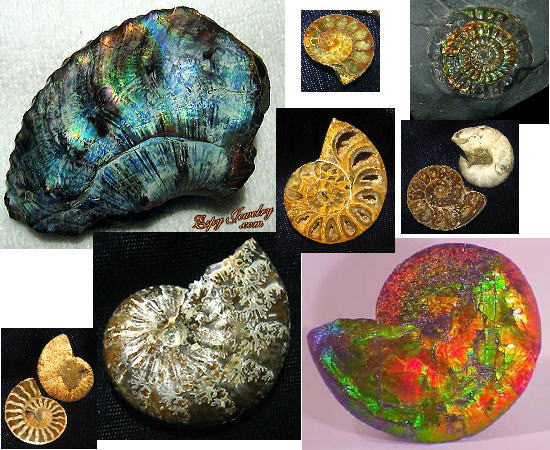
Ammonites are the fossilized remains of ancient sea creatures. A type of cephalopod mollusk, they are found around the world. Much of what we know or presume about ammonites comes from the study of their only known living relative, the nautilus. Most everyone has seen the pearly shell of a Nautilus and can therefore picture what an ammonite was, even though they probably became extinct about the same time as the dinosaurs.
Over time, ammonite fossils were pushed up to the surface or washed out into rivers. These fossils have fascinated people throughout the ages. There is various lore surrounding ammonite fossils, but all seem to attribute health, prosperity, and good luck to the fossils.
The fossil is named for the Egyptian god Ammon, because their shape resembles his ram horns. Ammonite was prized by the ancient Egyptian and Roman societies and was considered to have magical and holy powers.
Ammonite/Ammolite from Alberta, Canada represents abundance, good health, and stamina to the Blood tribe (a member of the Blackfoot Confederacy). Click here to read more about Buffalo Stone and Blackfoot legend.
Ammonite is known as "snake stones" in Whitby, England, where there was an abundance of these fossils. Local legend attributed these objects to St. Hilda, who supposedly rid the abbey of snakes by casting a spell on them to behead them, causing them to curl up into spirals and turn to stone.
People that believe in the metaphysical aspects of stones ascribe many properties to ammonite. It is considered to be a protective stone that gives stability and structure to a person’s life. It is said to change negativity into smoothly flowing energy. It is also said to assist with childbirth, depression, and general survival instincts.
Eastern cultures consider shells in general to be symbols of good luck & prosperity. They are a symbol of the higher forces of the universe and their shape is said to attract and store wealth. People that believe in Feng Shui in particular may consider ammonite - particularly that with an exterior layer of ammolite - a high energy stone that enhances the vitality, harmony, prosperity, and overall well-being of occupants and visitors of a home.
Feng Shui believers seem to layer beliefs on ammonite/ammolite. First, the ammonite in general is believed to have absorbed the knowledge of the universe, storing that energy in the spirals of the shell and radiating it out, to the benefit of anyone near it. Then, when the ammonite has a layer of ammolite on the exterior of the shell, that ammolite has the energy of light from the centuries. The colors of ammolite represent the harmonious balance of fire, earth, metal, water, and wood. Ammonite with ammolite is particularly thought to enhance the flow of Qi (Chi)(life energy), to radiate strength, and to change negative energy into positive energy. Its presence is considered beneficial even for those that do not believe in Feng Shui.
Some of the Feng Shui sites talk about needing high quality ammolite, to have high energy. I initially passed this off as just a marketing ploy, but on the Miscellaneous Information page I do have some information about the difference between diffraction and reflection. As ammolite diffracts light, perhaps the interference patterns created in the higher quality gems do indeed create more energy. There is also a section on the Miscellaneous Information page talking about the difference between ammonite and ammolite.
Ammonite fossils sold whole may be polished or unpolished. Fossils cut in half are normally polished on the cut side. The inner sections of the cut shells are often filled with different minerals and sometimes have druze pockets. Some nice ammonite fossil specimens come from Madagascar and Russia. Many ammonite fossils are a chalky white color on the outer surfaces, however, some have extremely intricate and beautiful suture patterns. Some have iridescent nacre on the exterior, usually in white, red, or green colors - these are sometimes sold as having ammolite on them, but once you have seen gem ammolite - well, it is just not the same thing.

Some ammonite fossils, when I look at them, the phrase "trapped light of the ages" comes immediately to mind. They have been polished and as you turn them reds, oranges, and/or greens just glow, like the fossil is lit from within. This image is courtesy of Ismor Fischer and if you follow the link and go about half way down the page, he also has images of wonderful ammolite fossils with irridescent colors on the exterior.
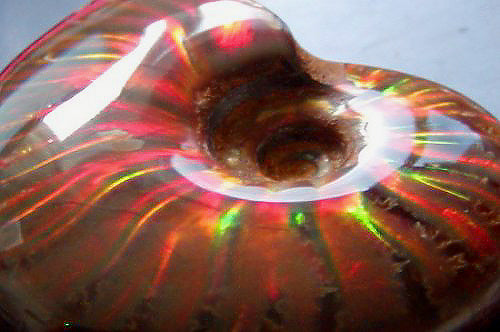
And, of course, there are wonderful ammonite fossils encased in gem ammolite, like this one, courtesy of lizardbackammolite. And you can see how turning the fossil just a little bit changes the colors, bringing out so much more blue.
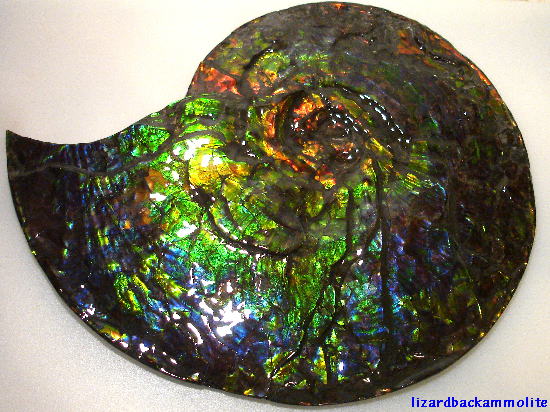
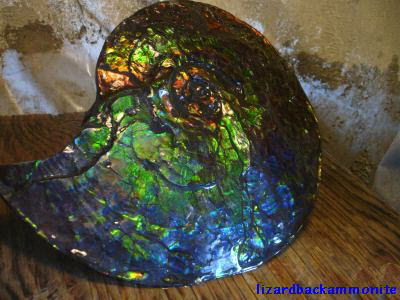
The images at the top of the page are ammonites in my collection, with the exception of the one in the bottom right corner. That one I only wish was in my collection. It is an image from the ammonite.com fossil catalog and would set me back $50,000 or more to add it to my collection. Here is an image showing both sides of the fossil, the other side has more blues, purples, and greens.
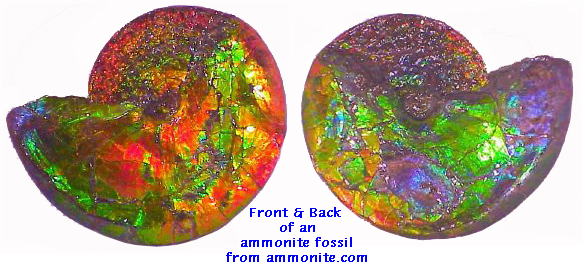
Cephalopod / Cephalopod Mollusk:
A variety of marine mollusks in the class Cephalopoda characterized by well-developed heads, large eyes, and tentacles. There are approximately 600 Cephalopod species existing today, including the octupus, squid, cuttlefish, and nautilus, however there are approximately 10,000 fossil species, including ammonites.
Ammonite species are believed to have lived from the mid to late Paleozoic Era (~500 million years ago) through the end of the Mesozoic Era (Cretaceous Period, ~65 million years ago) when the dinosaurs also disappeared. Most species had tightly coiled, chambered, spiral shells. Some types of ammonites, most notably baculites, grew long, straight shells as they matured. Others grew loosely coiled to twisted coiled shells. The soft creature is thought to have been squid-like and it lived in the open, last chamber of the shell.
Ammonite species are determined in part by the suture line patterns on the fossils, where the septa partitioning the chambers joined the outer shell. They can be quite simple, just straight lines going over the outside curve of the fossil, to squiggly line patterns, to extremely elaborate, lacy, "frost" patterns. Most ammonites are smooth-shelled, but some have ridges, knobs, horns, etc. The males and females of the species are thought to be dimorphic - different in size and appearance. Use this link and go down about half-way on the page to see some wonderful pictures of ammonite fossils. (Please let me know if this link quits working.)
There were two species of Placenticeras ammonite and a species Baculites compressus in the Bearpaw sea where ammolite is found. Placenticeras Meeki is a smooth shelled ammonite, like the one pictured in the bottom right corner of the ammonite pictures at the top of the page. Placenticeras Intercalare is an ammonite with ridges and "horns", like the one pictured in the upper left corner of the ammonite pictures. The Placenticeras Intercalare is the rarer of the two and is thought to have been the male of the species. It is smaller and appears to have led a solitary life. Placenticeras Meeki is thought to have been the female of the species. It is possible that they cared for their eggs within their shell, not eating while doing this, and died after the young swam away. They are thought to have gathered into groups to care for their eggs, leaving large groupings of shells found close together.
Circular marks in ammolite/ammonite shells most often come from limpets and similar creatures that dissolve the shell. Occasionally fossils are found with holes in the shell in the tell-tale pattern of a mosasaur bite mark.
Nautilus:
The nautiloid group was also present during this time period. Members of this group continue to exist today and are considered primitive cephalopods, in that they still have large external shells, where as the more modern members of the cephalopods have evolved away from external shell structures.
Study of the past is a mixture of "facts" - measurable, observable things such as fossils, and "speculation" - often formed by the study of what can be observed today. Trying to understand what ammonites were can be helped along by looking at today’s chambered nautilus.
The smooth, coiled shell section contains a series of compartments thought to help regulate buoyancy. There are males & females - the females appear to grow larger than the males. Embryos develop in egg masses cared for by the females. The babies hatch fully formed, with a coiled shell. It is thought that the heavy ridge near the base of the coil represents the shell that existed at the time of hatching.
Whereas the ammonites lived in shallow waters, the chambered nautilus lives in deep waters. It is thought that the great depths that the eggs are laid at, coupled with the long time period between when they are laid and when they hatch, allowed the chambered nautilus to survive whatever caused the death of the dinosaurs.
Click on the following links for pictures of a live chambered nautilus and a chambered nautilus shell, cut in half lenthwise, to show the interior chambers.
(Please let me know if either of these links quit working.)
Chambered nautilus shells like the one in the pictures below are popular decorator items. Normally you think of the shell as being white, as in the first picture, where the shell is tipped backwards. However, as you change the light, the shell becomes creamier in color and as you turn it, you can see red/pink and green bands in the shell. These bands of color remind one very much of the reds, oranges and greens that appear like "trapped light" in some ammonite fossils.
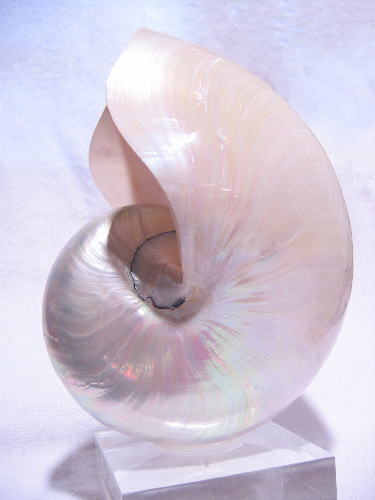
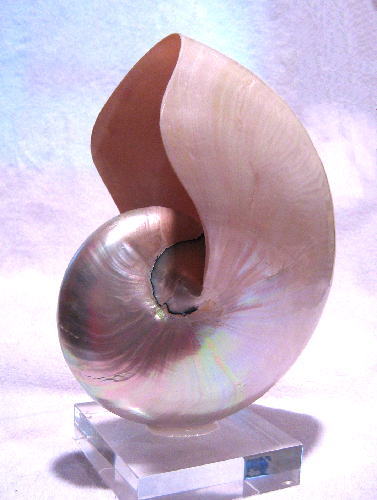

Continue Reading
Ammolite ~~ Ammonite ~~ Unearthed ~~ Misc Info ~~ Gem Stones ~~ Lore ~~ Rockhounds
Ammonite fossils show the shape of the creature. Ammolite is the shell of the creature.

Ammonites are the fossilized remains of ancient sea creatures. A type of cephalopod mollusk, they are found around the world. Much of what we know or presume about ammonites comes from the study of their only known living relative, the nautilus. Most everyone has seen the pearly shell of a Nautilus and can therefore picture what an ammonite was, even though they probably became extinct about the same time as the dinosaurs.
Over time, ammonite fossils were pushed up to the surface or washed out into rivers. These fossils have fascinated people throughout the ages. There is various lore surrounding ammonite fossils, but all seem to attribute health, prosperity, and good luck to the fossils.
The fossil is named for the Egyptian god Ammon, because their shape resembles his ram horns. Ammonite was prized by the ancient Egyptian and Roman societies and was considered to have magical and holy powers.
Ammonite/Ammolite from Alberta, Canada represents abundance, good health, and stamina to the Blood tribe (a member of the Blackfoot Confederacy). Click here to read more about Buffalo Stone and Blackfoot legend.
Ammonite is known as "snake stones" in Whitby, England, where there was an abundance of these fossils. Local legend attributed these objects to St. Hilda, who supposedly rid the abbey of snakes by casting a spell on them to behead them, causing them to curl up into spirals and turn to stone.
People that believe in the metaphysical aspects of stones ascribe many properties to ammonite. It is considered to be a protective stone that gives stability and structure to a person’s life. It is said to change negativity into smoothly flowing energy. It is also said to assist with childbirth, depression, and general survival instincts.
Eastern cultures consider shells in general to be symbols of good luck & prosperity. They are a symbol of the higher forces of the universe and their shape is said to attract and store wealth. People that believe in Feng Shui in particular may consider ammonite - particularly that with an exterior layer of ammolite - a high energy stone that enhances the vitality, harmony, prosperity, and overall well-being of occupants and visitors of a home.
Feng Shui believers seem to layer beliefs on ammonite/ammolite. First, the ammonite in general is believed to have absorbed the knowledge of the universe, storing that energy in the spirals of the shell and radiating it out, to the benefit of anyone near it. Then, when the ammonite has a layer of ammolite on the exterior of the shell, that ammolite has the energy of light from the centuries. The colors of ammolite represent the harmonious balance of fire, earth, metal, water, and wood. Ammonite with ammolite is particularly thought to enhance the flow of Qi (Chi)(life energy), to radiate strength, and to change negative energy into positive energy. Its presence is considered beneficial even for those that do not believe in Feng Shui.
Some of the Feng Shui sites talk about needing high quality ammolite, to have high energy. I initially passed this off as just a marketing ploy, but on the Miscellaneous Information page I do have some information about the difference between diffraction and reflection. As ammolite diffracts light, perhaps the interference patterns created in the higher quality gems do indeed create more energy. There is also a section on the Miscellaneous Information page talking about the difference between ammonite and ammolite.
Ammonite fossils sold whole may be polished or unpolished. Fossils cut in half are normally polished on the cut side. The inner sections of the cut shells are often filled with different minerals and sometimes have druze pockets. Some nice ammonite fossil specimens come from Madagascar and Russia. Many ammonite fossils are a chalky white color on the outer surfaces, however, some have extremely intricate and beautiful suture patterns. Some have iridescent nacre on the exterior, usually in white, red, or green colors - these are sometimes sold as having ammolite on them, but once you have seen gem ammolite - well, it is just not the same thing.

Some ammonite fossils, when I look at them, the phrase "trapped light of the ages" comes immediately to mind. They have been polished and as you turn them reds, oranges, and/or greens just glow, like the fossil is lit from within. This image is courtesy of Ismor Fischer and if you follow the link and go about half way down the page, he also has images of wonderful ammolite fossils with irridescent colors on the exterior.

And, of course, there are wonderful ammonite fossils encased in gem ammolite, like this one, courtesy of lizardbackammolite. And you can see how turning the fossil just a little bit changes the colors, bringing out so much more blue.


The images at the top of the page are ammonites in my collection, with the exception of the one in the bottom right corner. That one I only wish was in my collection. It is an image from the ammonite.com fossil catalog and would set me back $50,000 or more to add it to my collection. Here is an image showing both sides of the fossil, the other side has more blues, purples, and greens.

Cephalopod / Cephalopod Mollusk:
A variety of marine mollusks in the class Cephalopoda characterized by well-developed heads, large eyes, and tentacles. There are approximately 600 Cephalopod species existing today, including the octupus, squid, cuttlefish, and nautilus, however there are approximately 10,000 fossil species, including ammonites.
Ammonite species are believed to have lived from the mid to late Paleozoic Era (~500 million years ago) through the end of the Mesozoic Era (Cretaceous Period, ~65 million years ago) when the dinosaurs also disappeared. Most species had tightly coiled, chambered, spiral shells. Some types of ammonites, most notably baculites, grew long, straight shells as they matured. Others grew loosely coiled to twisted coiled shells. The soft creature is thought to have been squid-like and it lived in the open, last chamber of the shell.
Ammonite species are determined in part by the suture line patterns on the fossils, where the septa partitioning the chambers joined the outer shell. They can be quite simple, just straight lines going over the outside curve of the fossil, to squiggly line patterns, to extremely elaborate, lacy, "frost" patterns. Most ammonites are smooth-shelled, but some have ridges, knobs, horns, etc. The males and females of the species are thought to be dimorphic - different in size and appearance. Use this link and go down about half-way on the page to see some wonderful pictures of ammonite fossils. (Please let me know if this link quits working.)
There were two species of Placenticeras ammonite and a species Baculites compressus in the Bearpaw sea where ammolite is found. Placenticeras Meeki is a smooth shelled ammonite, like the one pictured in the bottom right corner of the ammonite pictures at the top of the page. Placenticeras Intercalare is an ammonite with ridges and "horns", like the one pictured in the upper left corner of the ammonite pictures. The Placenticeras Intercalare is the rarer of the two and is thought to have been the male of the species. It is smaller and appears to have led a solitary life. Placenticeras Meeki is thought to have been the female of the species. It is possible that they cared for their eggs within their shell, not eating while doing this, and died after the young swam away. They are thought to have gathered into groups to care for their eggs, leaving large groupings of shells found close together.
Circular marks in ammolite/ammonite shells most often come from limpets and similar creatures that dissolve the shell. Occasionally fossils are found with holes in the shell in the tell-tale pattern of a mosasaur bite mark.
Nautilus:
The nautiloid group was also present during this time period. Members of this group continue to exist today and are considered primitive cephalopods, in that they still have large external shells, where as the more modern members of the cephalopods have evolved away from external shell structures.
Study of the past is a mixture of "facts" - measurable, observable things such as fossils, and "speculation" - often formed by the study of what can be observed today. Trying to understand what ammonites were can be helped along by looking at today’s chambered nautilus.
The smooth, coiled shell section contains a series of compartments thought to help regulate buoyancy. There are males & females - the females appear to grow larger than the males. Embryos develop in egg masses cared for by the females. The babies hatch fully formed, with a coiled shell. It is thought that the heavy ridge near the base of the coil represents the shell that existed at the time of hatching.
Whereas the ammonites lived in shallow waters, the chambered nautilus lives in deep waters. It is thought that the great depths that the eggs are laid at, coupled with the long time period between when they are laid and when they hatch, allowed the chambered nautilus to survive whatever caused the death of the dinosaurs.
Click on the following links for pictures of a live chambered nautilus and a chambered nautilus shell, cut in half lenthwise, to show the interior chambers.
(Please let me know if either of these links quit working.)
Chambered nautilus shells like the one in the pictures below are popular decorator items. Normally you think of the shell as being white, as in the first picture, where the shell is tipped backwards. However, as you change the light, the shell becomes creamier in color and as you turn it, you can see red/pink and green bands in the shell. These bands of color remind one very much of the reds, oranges and greens that appear like "trapped light" in some ammonite fossils.



Continue Reading
Ammolite ~~ Ammonite ~~ Unearthed ~~ Misc Info ~~ Gem Stones ~~ Lore ~~ Rockhounds
 Unique, One-of-a-Kind Settings for Unique, One-of-a-Kind Stones
Unique, One-of-a-Kind Settings for Unique, One-of-a-Kind Stones